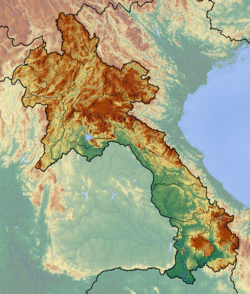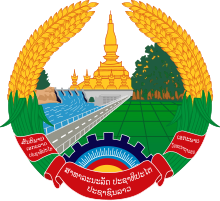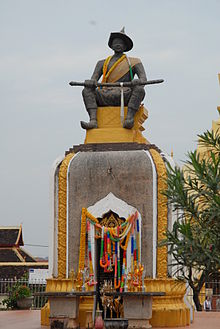IHE Wiki
Portal:Laos/Intro
Laos (/ˈlɑːoʊs/ , /ˈlaʊs/, /ˈlɑːɒs/, or /ˈleɪɒs/; Lao: ລາວ, Lao pronunciation: [láːw], Lāo), or commonly referred to its colloquial name of Muang Lao (Lao: ເມືອງລາວ, Muang Lao), is a landlocked country in the heart of the Indochinese peninsula of Mainland Southeast Asia, bordered by Myanmar (Burma) and China to the northwest, Vietnam to the east, Cambodia to the southwest, and Thailand to the west and southwest. It traces its historic and cultural identity to the kingdom of Lan Xang Hom Khao (Kingdom of a Million Elephants Under the White Parasol), which existed for four centuries as one of the largest kingdoms in Southeast Asia. Due to Lan Xang's central geographical location in Southeast Asia, the kingdom was able to become a popular hub for overland trade, becoming wealthy economically as well as culturally. After a period of internal conflict, Lan Xang broke off into three separate kingdoms — Luang Phrabang, Vientiane, and Champasak. In 1893, it became a French protectorate, with the three territories uniting to form what is now known as the country of Laos. It briefly gained freedom in 1945 after Japanese occupation, but was recolonised by France until it won autonomy in 1949. Laos became independent in 1953 under King Sisavang Vong. The capital city is Vientiane. Other large cities include Luang Prabang, Savannakhet, and Pakse. The official language is Lao. Laos is a multi-ethnic country with the politically and culturally dominant Lao people making up approximately 60 percent of the population, mostly in the lowlands. Mon-Khmer groups, the Hmong, and other indigenous hill tribes, accounting for 40 percent of the population, live in the foothills and mountains. Laos' ambitious strategies for development are based on generating electricity from its rivers and selling the power to its neighbors, namely Thailand, China, and Vietnam, as well as its initiative to become a 'land-linked' nation, shown by the planning of four new railways connecting Laos to those same countries. This, along with growth of the mining sector, Laos has been referred to as one of East Asia and Pacific's fastest growing economies by the World Bank, with annual GDP growth averaging 7% for the past decade. It is a member of the Asia-Pacific Trade Agreement (APTA), Association of Southeast Asian Nations (ASEAN), East Asia Summit and La Francophonie. Laos became a member of the World Trade Organization (WTO) in 2013. Selected article -The Prime Minister of the Lao People's Democratic Republic, formerly the chairman of the Council of Government of the Lao People's Democratic Republic, is the head of government of Laos. The highest position in the government, they direct the country's executive branch. The prime minister is accountable to the president, the National Assembly and the country's only legal party: the Lao People's Revolutionary Party (LPRP). The current prime minister is Sonexay Siphandone, who was elected in 2022. The Kingdom of Luang Phrabang was the first Laotian state to establish the office of prime minister. The Constitution of the Kingdom of Laos, ratified in 1947, established the post of Prime Minister of the Kingdom of Laos. The kingdom was abolished on 2 December 1975, when the National Congress of People's Representatives established the Lao People's Democratic Republic. The congress established the office of prime minister, forming the First Government on that day. The Supreme People's Assembly (SPA) approved the Law on the Council of Government, regulating the government's decision-making process, in 1982. The Constitution was approved on 14 August 1991, and the Prime Minister was made subordinate to the President. (Full article...)General images -The following are images from various Laos-related articles on Wikipedia.
Related portalsSoutheast Asia Other Countries Selected biography -
Setthathirath (Lao: ເສດຖາທິຣາດ; 24 January 1534 – 1571) or Xaysettha (Lao: ໄຊເສດຖາ; Thai: ไชยเชษฐาธิราช, RTGS: Chaiyachetthathirat, Burmese: ဇယဇေဋ္ဌာဓိရာဇ် Jayajyeṣṭhādhirāja) is considered one of the great leaders in Lao history. Throughout the 1560s until his death, he successfully defended his kingdom of Lan Xang against military campaigns of Burmese conqueror Bayinnaung, who had already subdued Xieng Mai (Chiang Mai) in 1558 and Ayutthaya in 1564. Setthathirath was a prolific builder and erected many Buddhist monuments including Wat Xieng Thong in Luang Prabang, Haw Phra Kaew, Wat Ong Teu Mahawihan and the Pha That Luang in Vientiane. (Full article...)
Selected picture View of Pha That Luang, Vientane. WikiProjects
TopicsCategoriesDid you know?
Tasks
Associated WikimediaThe following Wikimedia Foundation sister projects provide more on this subject:
ContributorsDiscover Wikipedia using portals
Purge server cache | |||||||||

















































































